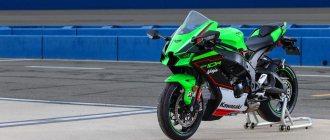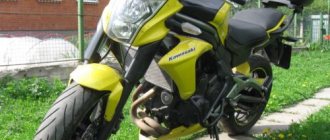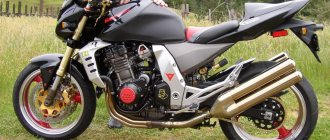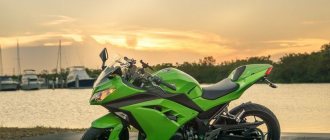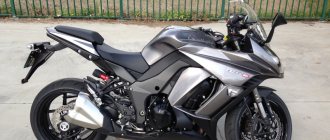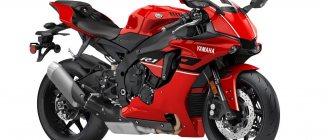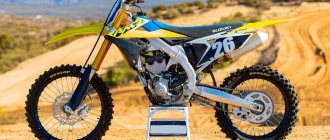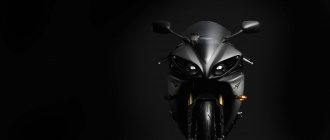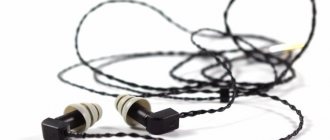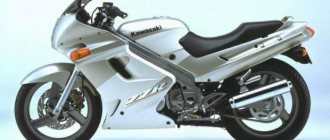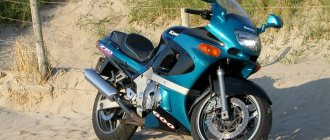| Kawasaki ZX-10R (ZX1000C) 2004-2005 | Kawasaki ZX-10R (ZX1000D) 2006-2007 | Kawasaki ZX-10R (ZX1000E) 2008-2009 | Kawasaki ZX-10R (ZX1000F) 2010 |
| Kawasaki ZX-10R + ABS (ZX1000J-K) 2011-2015 | Kawasaki ZX-10R + ABS (ZX1000S-R) 2016-2020 | Kawasaki ZX-10RR (ZX1000Z) 2017-2020 | Kawasaki ZX-10R SE (ZX1002C) 2018-2020 |
| Kawasaki ZX-10R (ZX1002-L) 2021+ | Kawasaki ZX-10RR Limited (ZX1002-N) 2021 |
Kawasaki ZX-10R sports motorcycle model
was first introduced in 2004 as a successor to the Kawasaki ZX-9R. The appearance of the model was due to intense competition and the rapid development of the class of liter sports motorcycles, built in the image and likeness of racing prototypes.
The Kawasaki ZX-10R model was developed from scratch, receiving a new ultra-stiff and lightweight aluminum frame, a new 998 cm³ fuel-injected engine and a new, more modern chassis - an inverted fork at the front, 4-piston radial-mount calipers, lightweight wheels disks. As a result, compared to its predecessor, the curb weight decreased to 196 kg, and the maximum power increased to 175 hp. This was the first generation of the motorcycle. Factory code - ZX1000C
.
In 2006, the model undergoes a restyling, receiving a dual under-seat exhaust, slightly changing overall dimensions and increasing curb weight to 202 kg. The rear tire profile is increasing: instead of size 190/50 ZR17 (73W), a new one is offered - 190/55 ZR17 (75W). Factory designation - ZX1000D
.
For 2008, the model receives noticeable visual changes, returns to a single-sided exhaust, increases curb weight to 208 kg, gets larger front brake discs (310 mm instead of 300 mm), gets a different fuel injection system (Keihin TTK43 instead of Mikuni 43 EIDW), increases the engine compression ratio (12.9 versus 12.7), which also increases maximum performance to 188 hp. Factory model designation - ZX1000E
.
2010 was marked by a minor update of the model. The design of the plastics and headlights has changed slightly, and the motorcycle is equipped with an upgraded Öhlins steering damper. Factory designation - ZX1000F
.
For 2011, the Kawasaki ZX-10R undergoes major changes. The motorcycle gets a new appearance and new equipment: a new Showa Big Piston Fork (BPF), a new rear suspension with a horizontal shock absorber, new lightweight three-spoke wheels, a new fuel injection system (increasing the diameter of the throttle valves), increasing the engine compression ratio (13.0 instead of 12.9). The Kawasaki Traction Control (S-KTRC) traction control system is now standard, and versions with ABS (Kawasaki Intelligent Braking System - KIBS) are also appearing. All these changes increased the maximum power to 200 hp. and significantly reduced the curb weight - to 198 kg. Factory designation - ZX1000J
,
ZX1000K
.
For 2021, the ZX-10R gets changes again. In addition to the appearance, the model receives changes to the engine, increasing maximum power to 203 hp. (213 hp with inertial supercharging). The conventional traction control system is replaced by the more advanced Kawasaki Sport Traction Control (S-KTRC). The diameter of the front brake discs increases to 330 mm, also receiving new Brembo M50 calipers. Brake hoses now come reinforced from the factory. New Showa Balance Free Fork taken from the WSBK prototypes. This generation is equipped with the following electronic systems: Kawasaki Launch Control Mode (KLCM), Kawasaki Intelligent anti-lock Brake System (KIBS), Kawasaki Sport Traction Control (S-KTRC), Kawasaki Engine Braking Control, Kawasaki Quick Shifter (KQS) (only " up"), Kawasaki Corner Management Function (KCMF). Factory designation: ZX1000S
,
ZX1000R
.
In 2021, the ZX-10R line is replenished with a new modification - Kawasaki ZX-10RR
.
The modification is distinguished by the design of the cylinder head, 7-spoke Marchesini wheels and the ability to order a race-kit with other camshafts, valve tappets with DLC (reduces friction force by up to 66%) and a crankshaft bed. Also, the RR modification has the following electronic assistants: Kawasaki Launch Control Mode (KLCM), Kawasaki Intelligent anti-lock Brake System (KIBS), Kawasaki Sport Traction Control (S-KTRC), Kawasaki Engine Braking Control, Kawasaki Quick Shifter (KQS) (“ up" & "down"), Kawasaki Corner Management Function (KCMF). Factory designation - ZX1000Z
.
In 2021, an SE modification appears, which is based on the RR version, but is additionally equipped with electronically adjustable suspensions - the KECS (Kawasaki Electronic Control Suspension) system. Factory designation: ZX1002C
.
For 2021, Kawasaki has introduced the new ZX-10R and ZX-10RR. The new generation received an updated appearance, a new generation of suspensions, internal changes to the engine, improvements to the geometry of the chassis and expanded electronic equipment - LED optics, color TFT instrument panel, IMU (Inertial Measurement Unit), quick shifter down and up KQS (Kawasaki Quick Shifter), electronic cruise control, Power Mode selection and Smartphone connectivity. The ZX-10RR version features lightweight piston and titanium connecting rods, lightweight Marchesini wheels with Pirelli Diablo Supercorsa SP tires, and suspension settings. Factory designation: ZX1002-L
(ZX-10R);
ZX1002-N
(ZX-10RR).
Kawasaki ZX-10R/RR (2021+): electronic equipment
- KIBS (Kawasaki Intelligent anti-lock Brake System)
- ABS (Anti-lock Brake System)
- KLCM (Kawasaki Launch Control Mode)
- Kawasaki Engine Brake Control
- KCMF (Kawasaki Cornering Management Function)
- IMU (Inertial Measurement Unit)
- KQS (Kawasaki Quick Shifter) up/down
- S-KTRC (Sport-Kawasaki TRaction Control)
- Power Mode selection
- Electronic cruise control
- Smartphone connectivity
- Full LED optics
- Fully digital color TFT instrument panel
The main competitors of the Kawasaki ZX-10R in the class:
- Honda CBR1000RR
- Suzuki GSX-R1000
- Yamaha YZF-R1
Brief history of the model
- 2004 - start of production and sales. First generation
.
Model
: Kawasaki Ninja ZX-10R (Europe, North America, Asia).
Factory designation
: ZX1000-C1.
- 2005 - no significant changes.
Model
: Kawasaki Ninja ZX-10R (Europe, North America, Asia).
Factory designation
: ZX1000-C2.
- 2006 - restyling of the model. Second generation
.
Model
: Kawasaki Ninja ZX-10R (Europe, North America, Asia).
Factory designation
: ZX1000-D6F.
- 2007 - no significant changes.
Model
: Kawasaki Ninja ZX-10R (Europe, North America, Asia).
Factory designation
: ZX1000-D7F.
- 2008 - restyling of the model. Third generation
.
Model
: Kawasaki Ninja ZX-10R (Europe, North America, Asia).
Factory designation
: ZX1000-E8F.
- 2009 - no significant changes.
Model
: Kawasaki Ninja ZX-10R (Europe, North America, Asia).
Factory designation
: ZX1000-E9F.
- 2010 - minor changes. Fourth generation
.
Model
: Kawasaki Ninja ZX-10R (Europe, North America, Asia).
Factory designation
: ZX1000-FAF.
- 2011 - restyling of the model. Fifth generation
.
Model
: Kawasaki Ninja ZX-10R + ABS (Europe, North America, Asia).
Factory designation
: ZX1000-JBF + ZX1000-KBF.
- 2012 - no significant changes.
Model
: Kawasaki Ninja ZX-10R + ABS (Europe, North America, Asia).
Factory designation
: ZX1000-JCF + ZX1000-KCF.
- 2013 - no significant changes.
Model
: Kawasaki Ninja ZX-10R + ABS (Europe, North America, Asia).
Factory designation
: ZX1000-JDF + ZX1000-KDF.
- 2014 - no significant changes.
Model
: Kawasaki Ninja ZX-10R + ABS (Europe, North America, Asia).
Factory designation
: ZX1000-JEF + ZX1000-KEF.
- 2015 - no significant changes.
Model
: Kawasaki Ninja ZX-10R + ABS (Europe, North America, Asia).
Factory designation
: ZX1000-JFF + ZX1000-KFF.
- 2016 - restyling of the model. Sixth generation
.
Model
: Kawasaki Ninja ZX-10R + ABS (Europe, North America, Asia).
Factory designation
: ZX1000RGF + ZX1000SGF.
- 2017 - appearance of the RR modification.
Model
: Kawasaki Ninja ZX-10R + ABS;
Kawasaki Ninja ZX-10RR (Europe, North America, Asia). Factory designation
: ZX1000RHF + ZX1000SHF; ZX1000ZHF.
- 2018 - appearance of the SE modification.
Model
: Kawasaki Ninja ZX-10R + ABS;
Kawasaki Ninja ZX-10RR; Kawasaki Ninja ZX-10R SE (Europe, North America, Asia). Factory designation
: ZX1000RJF + ZX1000SJF; ZX1000ZJF; ZX1002CJF.
- 2019 - no significant changes.
Model
: Kawasaki Ninja ZX-10R + ABS;
Kawasaki Ninja ZX-10RR; Kawasaki Ninja ZX-10R SE (all regions). Factory designation
: ZX1002EKF (ABS), ZX1002FKF, ZX1002GKF (RR), ZX1002HKF (SE).
- 2020 - no significant changes.
Model
: Kawasaki Ninja ZX-10R ABS;
Kawasaki Ninja ZX-10R SE (all regions). Factory designation
: ZX1002EKLF (ABS), ZX1002HLF (SE).
- 2021 - restyling of the model. Seventh generation
.
Model
: Kawasaki Ninja ZX-10R ABS;
Kawasaki Ninja ZX-10RR (all regions). Factory designation
: ZX1002LMFAN, ZX1002LMFAL; ZX1002NMFNN, ZX1002NMFNL.
- 2022 - no significant changes.
Model
: Kawasaki Ninja ZX-10R ABS (all regions).
Factory designation
: ZX1002LNFAN, ZX1002LNFAL.
Specifications
The engine on the Kawasaki Ninja ZX-10R fully meets sporting requirements.
Up close.
Like most sports motorcycles, the ZX-10R is equipped with a four-stroke gasoline engine, which has a huge advantage in acceleration.
Moreover, the working volume of such a power unit is 1000 cubic centimeters, for 4 working cylinders. And this is quite enough to accelerate the motorcycle from zero to hundreds in just 2.8 seconds .
| Model | Kawasaki ZX-10R |
| Motorcycle type | sports |
| Year of issue | 2004+ |
| Frame | aluminum |
| engine's type | 4-cylinder, 4-stroke, in-line |
| Working volume | 998 cm³ |
| Bore/Stroke | 76.0 x 55.0 mm |
| Compression ratio | 12.7:1 – ZX1000C-D 12.9:1 – ZX1000E-F 13.0:1 – ZX1000J-K, SR, ZX10RR, ZX-10R SE |
| Cooling | liquid |
| Number of valves per cylinder | DOHC, 4 valves per cylinder |
| Fuel supply system | Injector, 4x Mikuni 43 EIDW – ZX1000C-D Injector, 4x Keihin TTK43 – ZX1000E-F Injector, 4x Keihin TTK47 – ZX1000J-K, ZX1000S-R, ZX-10RR, ZX-10R SE |
| Ignition type | transistor |
| Maximum power | 175.0 hp (128.4 kW) at 11,700 rpm – ZX1000C-D 188.0 hp (138.3 kW) at 12500 rpm – ZX1000E-F 200.0 hp (147.1 kW) at 13,000 rpm – ZX1000J-K 203.0 hp (149.3 kW) at 13500 rpm – ZX1000S-R, ZX-10RR, ZX-10R SE 213.0 hp (156.8 kW) at 13500 rpm – ZX1000S-R, ZX-10RR, ZX-10R SE (supercharged) |
| Maximum torque | 115.0 Nm (11.7 kg*m) at 9500 rpm – ZX1000C-D 113.0 Nm (11.5 kg*m) at 8700 rpm – ZX1000E-F 112.0 Nm (11.4 kg*m) at 11500 rpm – ZX1000J-K 114.9 Nm (11.7 kg*m) at 11200 rpm – ZX1000S-R, ZX-10RR, ZX-10R SE |
| Transmission | 6-speed |
| type of drive | chain |
| Front tire size | 120/70 ZR17 (58W) |
| Rear tire size | 190/50 ZR17 (73W) – ZX1000C 190/55 ZR17 (75W) – ZX1000D+ |
| Front brakes | 2 discs, 300 mm, 4-piston radial calipers – ZX1000C-D 2 discs, 310 mm, 4-piston radial calipers – ZX1000E-K (K – KIBS ABS) 2 discs, 330 mm, 4-piston radial calipers – ZX- 10R (2016+) KIBS ABS |
| Rear brakes | 1 disc, 220 mm, 1-piston caliper (2011+ - optional KIBS ABS) |
| Front suspension | 43mm inverted fork (fully adjustable), 120mm travel Kawasaki Electronic Control Suspension (KECS) – ZX-10R SE |
| Rear suspension | Uni-trak swingarm with monoshock (fully adjustable), 125 mm travel – ZX1000C-F Swingarm with horizontal monoshock (fully adjustable), travel – 140 mm – ZX1000J-K Swingarm with horizontal monoshock (fully adjustable), travel – 115 mm – ZX1000S-R, ZX10R SE, ZX10RR Kawasaki Electronic Control Suspension (KECS) – ZX-10R SE |
| Motorcycle length | 2045 mm – ZX1000C 2065 mm – ZX1000D 2110 mm – ZX1000E-F 2075 mm – ZX1000J-K 2085 mm – ZX1000S-R, ZX10R SE, ZX10RR |
| Motorcycle width | 705 mm – ZX1000C-D 710 mm – ZX1000E-F 715 mm – ZX1000J-K 740 mm – ZX1000S-R, ZX10R SE, ZX10RR |
| Motorcycle height | 1115 mm – ZX1000C, ZX1000J-K 1130 mm – ZX1000D 1135 mm – ZX1000E-F 1145 mm – ZX1000S-R, ZX10R SE, ZX10RR |
| Wheelbase | 1385 mm – ZX1000C 1390 mm – ZX1000D 1415 mm – ZX1000E-F 1425 mm – ZX1000J-K 1440 mm – ZX1000S-R, ZX10R SE, ZX10RR |
| Seat height | 825 mm – ZX1000C-D 830 mm – ZX1000E-F 813 mm – ZX1000J-K 835 mm – ZX1000S-R, ZX10R SE, ZX10RR |
| Minimum ground clearance (clearance) | 125 mm – ZX1000C, ZX1000E-F 120 mm – ZX1000D 135 mm – ZX1000J-K 145 mm – ZX1000S-R, ZX10R SE, ZX10RR |
| Acceleration to 100 km/h | 3.12 sec. – ZX1000C-D 2.84 sec. – ZX1000E-F 2.90 sec. – ZX1000J-K 2.80 sec. – ZX1000S-R, ZX-10RR, ZX-10R SE |
| Maximum speed | 299 km/h |
| Gas tank capacity | 17.0 l |
| Motorcycle weight (curb) | 196 kg – ZX1000C 202 kg – ZX1000D 208 kg – ZX1000E-F 198 kg – ZX1000J 201 kg – ZX1000K (ABS) 206 kg – ZX1000S-R, ZX10RR 208 kg – ZX-10R SE |
Maximum speed
The maximum speed with these engine characteristics reaches 300 km/h, which is more than enough for city driving.
Fuel consumption
But on the highway, with a consumption of 5.5 liters per 100 km and a tank capacity of 17 liters , such a unit can drive about three hundred kilometers.
The shape of the gas tank is designed so that the rider can lie down comfortably at high speeds, reducing aerodynamic drag.
Transmission
For ease of movement in heavy traffic, engineers equipped it with a 6-speed manual transmission with a reliable chain drive .
Classic chain drive.
Suspension
Driver safety depends entirely on the fully automatic pendulum-type suspension and new generation disc brakes.
Front brakes with two discs.
Single disc rear brake.
Reviews
Reviews about Kawasaki ZX-10R:
Expand Collapse
The bike is awesome, it's crazy, it gets into gear from the first gear just by opening the throttle, without even jerking it like on the VTR-1000 SP-1, which I also owned for 4 months, but no luck, the door was opened under my nose in a traffic jam (fuckers). The first gear easily spins up to 150 km per hour, the brakes, of course, the front discs are too small and reinforced hoses must be installed anyway. There are noticeably noticeable two pickups in the operating range of the engine, the first is so-so, but the second in the region of 9-10 thousand is like lightning. It easily reaches 270 km per hour, I think it will trample further.
I am writing this note mainly so that potential buyers of the first generation 10tok VERY CAREFULLY look at every centimeter of the frame weld. I saw such cracks not only on my motorcycle, but also on others running around Moscow. Kawasaki ZX10R 2004 had a defective frame that was cracking at the welds. No, not from goats and feet, but even from simple driving around the city. There are cases when a bike has 1,500 miles on it, and cracks are already visible... And the frame cracks as a result of a manufacturing defect - that’s a fact! The frame welding temperature was not maintained as expected. As a result, the frame immediately tracks, rather than damping under load. In 2005 the frame was changed. Even now, if you want to buy a 2004 frame, you won’t succeed. The part number will automatically be set to 2005. (verified)
World record stop at 220 km/h. Guess which motorcycle? Kawasaki ZX10R 2006. I sat on the P1 and, of course, on the ZX10R. P1 sucks on landing very seriously. Kava is faster, more controllable and has better brakes. And this is not just me saying this. And there are a lot of professionals here and abroad.
I've got a 2006 ten in all the cracks, the mileage under me is about 6, 14 in total. Not a single jamb. he loves the AI-98 very much - he drives it like crazy. It handles superbly, more nimble than the P1. It’s more comfortable in traffic jams because it’s narrower than the P1.
on the highway - for sports, soft, pleasant.
The box is clear, it works even more clearly than on the P1.
and nothing stops there. The damper in stock is Yolins, adjustable. on p1 I had to buy the same one, because the stock one is normal and not adjustable.
But on the ZX9R, my box fell apart and it didn’t work as great as on the ZX10.
I think that kava before -03 does not need to be considered - buckets. after that - normal spendthrifts without any special jambs.
Zx10 04 years old - frames burst, all other years - no problems were noticed. but I saw a couple of broken frames in '06! I don’t know why it happened, but there were only 2 cases. I think this is normal, this can happen to every spendthrift.
Owned 10 07, excellent motor. Brought from the states R1 07. and ZX10R 07, having driven both, I definitely chose the ZX10R. The Kava is lighter than the Erki, thinner, handles easily like a 600, is more driver-friendly and predictable, excellent plastic, few small parts, fits well. Among the shortcomings, I can only remember the branded adjustable damper, when turned up to maximum it seemed rather weak on our roads, but everything is very easy to treat, I drained the original oil and pumped it with dextron, it turned out just right. During the season of ownership it did not cause any problems, only good memories. But the Erka left mixed feelings, heavy and greasy, terrible vibration of the engine at the bottom, at first I thought that the engine was finished, disgusting plastic with a bunch of small parts that at speeds of about 300 climb out of the mounts and latches, although it tumbled in very well. I dreamed of an erk for many years, bought it, drove it, was disappointed and sold it, although everyone has their own opinion and everyone praises their swamp.
Dashboard
Initially there were analog instrument panels.
The instrument panel on the Kawasaki ZX-10R is made in a classic style: a round tachometer (at 18 thousand / rev), paired with a small LCD monitor. But unlike most similar samples, on the Japanese bike the display is divided into two parts, each of which shows its own indicators.
- The right side of the LCD monitor displays the current speed of the motorcycle, its actual mileage, engine temperature, and load on the crankshaft;
- The left side of the display shows the gear engaged and the current time.
The latest models have a fully digital panel.
The central display is like in a starship!
In addition, the dashboard of an aggressive sports bike also includes a whole set of additional indicator lights.
- Included right or left turn.
- Exceeding the maximum permissible speed.
- Problems with the motor.
- High beam on.
- Handbrake activated.
- Current oil pressure.
Based on all the above indicators, driving a motorcycle is much easier. And their location is so convenient that even a beginner will not be able to get confused in them.
013_moto_0211_052
An adjustable Ohlins twin-tube steering damper is standard on the bike.
The tachometer scale on the electronic instrument panel is made up of LEDs. When it's time to switch, it flashes (the parameter is configurable). An adjustable Ohlins twin-tube steering damper is standard on the bike. The tachometer scale on the electronic instrument panel is made up of LEDs. When it's time to switch, it flashes (the parameter is configurable).
Everything at a glance
- Twin Exhaust Pipes: In the new 4-2-1-2 exhaust system, the mufflers are located under the seat and shielded from the air blast.
- Turn Signals: Front and rear turn signals are mounted flush with the fairing, contributing to the aerodynamics of the body.
- Comfortable Riding Position: The spacing between the footpegs, seat and handlebars, along with the narrow fuel tank and frame, creates a naturally aggressive riding position, ideal for circuit racing.
- New liquid-cooled, single-row, 4-stroke, 4-cylinder engine: Thanks to micro-atomization injectors, friction-reducing measures and numerous engine design changes, it produces enormous power and meets stringent Euro III emissions standards.
- Racing Steering Damper: A specially designed steering damper provides consistent vibration compensation even in racing conditions.
- Aerodynamic body: The new front fairing gives the car a slippery, aerodynamic shape.
- Larger Rear Tire: The larger rear tire improves rear wheel traction and is highly compatible with racing style tires for increased traction.
- Footswitch Heel: A higher footswitch heel position provides improved rear wheel traction and allows for greater adjustment range.
- Chassis Geometry: The basic, twin-tube aluminum chassis features an all-new geometry and a high center of gravity, improving vehicle responsiveness during roll changes.
- High Crankshaft: The new engine has a higher crankshaft, which helps raise the center of gravity of the entire machine.
- Hybrid Instrument Cluster: A new, in-sight instrument cluster includes an analog tachometer and digital speedometer—both backlit.
- Changed Engine Layout: Numerous changes made to the layout help increase power while maintaining a 10R bank angle.
- Increased Flywheel Weight: Increased flywheel weight makes cornering easier, allowing for smooth, even engine power control.
- Petal Brake Discs: The addition of a radial hydraulically driven master cylinder on the front wheel allows the driver to have better brake feel with the excellent stopping power of triple discs.
000_moto_0211_052
Kawasaki ZX-10R Ninja: sportbike, 2011, 998 cm³, 200.1 hp, 198 kg.
Kawasaki ZX-10R Ninja: sportbike, 2011, 998 cm³, 200.1 hp, 198 kg.
It's no secret that Japanese concerns owe a lot to the German design school. The first successful Hondas of the 50s were the development of NSU ideas, Yamaha started with a copy of DKW, Suzuki creatively reworked Adler. In addition, the rise of the Japanese motorcycle industry “successfully” coincided with the decline of the German one, so that some German engineers found their second home in the Far East. But since then, an unimaginable amount of water, gasoline and engine oil has leaked. Now the Japanese are making the whole world dance to their tune, and for a long time no one has dared to challenge their absolute technical superiority in motorcycle technology. Nobody - except (oh, I’m tempted to say “small” - but I’m lying) the proud Bavarian “engine plant”. The BMW S1000RR has set new standards in engine technology, chassis perfection and on-board electronics. Its appearance was a shock: a European superbike, head and shoulders above the “Japanese” - and for the same money!
The failure in the established two-year update cycle of Japanese sportbikes is not only due to the crisis. And also because their creators are afraid of losing face: after all, their new products cannot be inferior in any way to the Bavarian upstart. So the revolutionary “blades”, “jiksers” and “eroks” will have to wait. As a consolation, there is the Kawasaki ZX-10R Ninja, the only new Japanese “liter” of the 2011 model. A huge industrial concern, which, according to everyone, deals with motorcycles only out of boredom, has found itself among the forefront for a reason. Once again, he decided to invigorate his superbike program and followed a proven path in this matter: he developed a racing motorcycle, slightly adapted for off-track riding.
So, a brand new engine, a chassis designed from scratch and an abundance of on-board electronics. The main thing that Japanese engineers sought when developing the engine was its absolutely linear characteristics, without any pick-ups or “shelves” of torque: as much as you opened the handle, you got as much adrenaline. In order for the torque to grow unhindered right up to the cutoff, they reduced internal friction (compared to last year, the piston skirts were shortened by 3.5 mm, the oil scraper rings became narrower by 0.3 mm, and the cylinder axes were shifted forward by 2 mm relative to crankshaft axis), increased the size of the valves and their lift (since it was necessary to install reinforced valve springs, the designers paid increased attention to the wear resistance of the camshafts - they are made of chrome-molybdenum steel), installed additional injectors on the intake and minimized the mass of the counterweights by using a balance shaft. To maximize the mass of the power unit to the center of mass, the developers chose a triangle arrangement of shafts: the input shaft of the gearbox (cassette type) sits much higher than the crankshaft and output shaft.
The result is a new record: 200.1 hp. at 13,000 rpm (7.1 hp more than the BMW S1000RR). One tenth was added clearly in order to beat the previous record holder - Yamaha VMAX with its 200 hp. smooth. And taking into account inertial boost, the new ZX-10R produces a full 209.9 hp.
The frame is as close as possible to the diagonal connecting the steering column and the rear suspension pendulum axis at the shortest distance. It consists of only seven aluminum castings: the reduction in the number of parts and the number of welds affects its rigidity in the most favorable way.
In the chassis, the front fork of the BPF system (Big Piston Fork, “fork with a large piston”) is presented as a great innovation. In fact, this is the same telescope of the “pre-cartridge” era: engineers suddenly realized that a large diameter piston (39.6 mm compared to last year’s 20 mm cartridge fork) allows for lower pressure while maintaining the same efficiency and thus provides better hydraulic performance, especially in the beginning of the move. In addition, this design is lighter and contains fewer parts.
Revolutions in the design of the new Ninja - forgive the expression - both front and rear. The usual Kawasaki Uni-Track rear suspension, with a vertical shock absorber and a linkage system under the swingarm, has been replaced by a Horizontal Back-link suspension - as its name suggests, with a horizontal shock absorber and a linkage system above the swingarm. According to the developers, with this arrangement it is possible to better maintain contact of the wheel with the road, the suspension is softer at the beginning of the stroke, and there is greater stability when taking high-speed turns. An additional plus is that the shock absorber and linkage system (the heaviest suspension parts) are placed closer to the center of mass.
And now about the most delicious thing - about electronics. Like many powerful modern sportbikes, the Kawasaki ZX-10R has a three-mode engine mode switch. In Full mode, the engine delivers full power, in Low mode - approximately 60%, Middle mode is intermediate: when you turn the throttle less than halfway, it coincides with Low, but if you open the gas more, it produces something in between Low and Full.
On the previous generation Ninja, the traction control worked “on a hunch” - it only took into account a sudden increase in engine speed, based on which it concluded that the rear wheel was slipping. The new ZX-10R features a much more sophisticated S-KTRC (Sport-Kawasaki TRaction Control) system. By processing data from wheel rotation sensors, engine speed, throttle opening degree, etc., it not only combats slipping, but also allows for its minimum degree (the best acceleration can be achieved when the wheel is slightly - but only slightly! - slipping) . In addition, the system also works as an anti-wheelie: it allows you to ride on the rear wheel “at the moment”, but prevents sudden unwanted “swings”. The driver can choose one of three operating modes of the system - or turn it off completely.
ABS on the new Ninja received its own designation - KIBS (Kawasaki Intelligent anti-lock Brake System), and for good reason. The engine control units and ABS constantly exchange data so that the system is able to recognize situations such as stoppage, slipping clutch, etc., and respond appropriately to them. It is important that ABS adds only 3 kg to the weight of the motorcycle - and one of them is due to the increased capacity battery.
By the way, the 2011 ZX-10R is lighter than last year's by as much as 10 kg, and 6 kg lighter than the BMW S1000RR. In the “competitor’s market” - in Germany - the Ninja costs 5 euros cheaper (15,495 euros versus 15,500 for the BMW), despite the fact that traction control for the “Japanese” is included in the standard equipment, while for the “German” it is available for an additional fee . The Russian price for the ZX-10R at the time of issue (early January) has not yet been announced, but, given the importer’s policy, it will certainly be tempting.
pros
Of the entire model range, the Kawasaki ZX-10R stands out for its large number of positive qualities that were noted by its owners.
Against the backdrop of similar competitors, Kawasaki's ZX-10R is instantly identifiable - a rare occurrence in the modern world of sports motorcycles.
This may include:
- Excellent distribution of gear ratios (in 1-2 gears the bike simply takes off, which saves time at traffic lights, and in 3-4 gears you can easily maneuver around the city. As for 5-6 gears, they are more suitable for high-speed tracks where a motorcycle can show all its power).
- Good maneuverability (despite the fact that the weight and dimensions of the ZX10R are quite impressive, it is very easy to drive it in dense traffic. The only thing you need to do is feel the center of gravity).
- Modern design (seven years after it entered the market, the bike still looks a little old and boring compared to other Japanese and American new products);
- Modest consumption (5.5 liters per 100 km for a sports car - this is a very good indicator).
Left handle.
Right handle.
Adjustable damper.
Tank filler neck.
Box under the rear seat.
Gear shift lever.
and cons
But, like any other equipment, the Japanese beauty also has several disadvantages, such as: an exorbitant price (the price for a new copy starts from 1.3 million rubles), and a harsh suspension , which often has to be adjusted manually.
Otherwise, such a motorcycle will not be inferior to competitors, even those released several years later.
Appearance
The motorcycle looks catchy. Stylish alloy wheels and a characteristic large exhaust pipe immediately make it clear that this is a sports car. As well as the characteristic shape of the frame with a completely closed filling. The shapes are sleek and aerodynamic, reflecting the model's modern origins as the angularity of the Eighties has fallen out of fashion. This is not surprising, because the higher the speed, the higher the requirements for frame bending.
Judging by the photos and videos, the car looks best on the race track. It has a very sporty design for an urban environment, and therefore sometimes such a motorcycle looks ridiculous against the backdrop of some ordinary residential areas. However, if these are neat townhouses, such a bike looks even more or less appropriate.
Comfort
The model is convenient for those who are used to riding sports motorcycles. The only possible riding position for this bike is crouched, reclining. This is due to the large distance between the steering wheel and the seat, as well as the high gas tank. This is normal, because the motorcycle is designed for high speeds and strong acceleration, for which only this position is appropriate.
Since the bike is still in production today, parts for it are easy to obtain. Therefore, maintenance will not be difficult. Plus, if you only use the bike for occasional rides on the race track, it's unlikely that anything will break down anytime soon. Like many other Kawasaki bikes, this model is very reliable.
The car also has good visibility through the windshield. It is unlikely that you will be able to look at the road differently at high speed. Already after the bike reaches 130 km/h the driver will begin to blow away if he does not bend down and take cover behind the glass. This or that description of sports models mentions this more than once.
Half a million Russian rubles is how much such a model costs. This is a lot of money for most, and therefore for many it would be more expedient to buy a cheaper sportbike. Also, do not forget that this machine is in no way suitable for off-road use, and for these purposes it is worth buying a motocross motorcycle.
Color codes and descriptions
LIM: Lime and Ebony “Ebony”
BLK: Ebony "Ebony"
SIL: Titanium metallic and ebony (in Europe)
dimensions
Compared to standard city motorcycles, the Japanese sport bike has impressive dimensions.
- In width , if measured from the edge of one mirror to the edge of the other, it will be about 740 mm .
- The length from the front wheel to the rear mudguard reaches as much as 2085 mm .
At the same time, a comfortable fit for the driver and passenger can be guaranteed by a small height - 1145 mm from the floor to the top of the rear seat. And if even with such dimensions the passenger encounters difficulties, then he can use the factory stands designed for such moments.
